Having fun with your dog in the snow is easy. Taking great pics of your pet while it rollicks and romps is so much harder! All the excitement can turn to disappoint in a flash. You get home and you find all your images are grey, not white, and your beloved dog looks like a blurry blob!
Let’s face it, if you’re going to take your best furiend to the snow, you want some breathtaking photos to match the scenery. Dogs love snow as much as us humans. It’s a winter wonderland brimming with new sights, sounds and smells. Your dog’s reaction will be priceless, so of course, you want a photo of them posing majestically against the pristine white landscape!
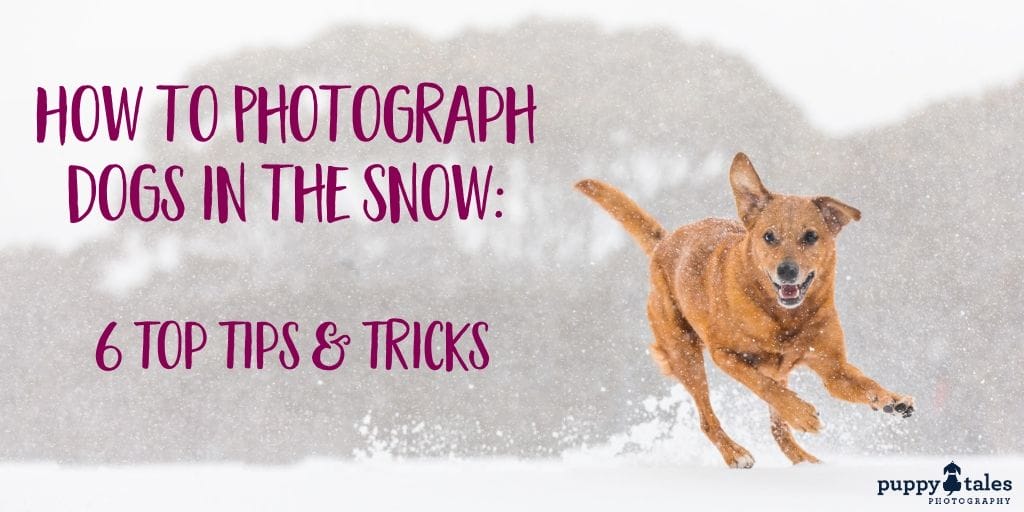
But, if you don’t know what you’re doing, it’s very likely you’ll end up with greyish underexposed photographs, far from the crisp white scenery in front of you. You may not even recognise your beloved pup as he/she turns out to be just a huge dark blob in the frame. And once you add in the complication of the very cold conditions and the fact that your dog, who officially loves snow, is so lively and excitable that it refuses to follow any of your posing directions, it’s a recipe for disaster!. It won’t take long for you to realise that photographing your dog in the snow needs special techniques to be able to get that incredible shot.
So, here are my six top tips and tricks to help you overcome these challenges and capture that pawfect photos!
Problem #1: Oh no, the snow’s gone grey! It’s time to turn off auto-exposure
Ending up with dark, muddy, and greyish photos of the snowscape and your dog? If you don’t have a grey dog, that means your photos are underexposed.
If you’re using automatic settings while taking photos in the snow, you’ll probably experience this. Why? Because the camera meter is reading the light reflected off the subject and is automatically aiming to set camera exposure for middle grey (18% percent in fact). So, when you are photographing your dog against a snowy background, the snow, being white, reflects a lot of light. This makes the camera assume there is too much light, thus leading to underexposure as it aims to reduce the scene to exposure for middle grey.
It’s even trickier if you’re trying to shoot your white-furred canine in the snow. White on white? It’s tough, but not impossible. You’ll need to make sure that your subject is properly exposed to preserve its details.
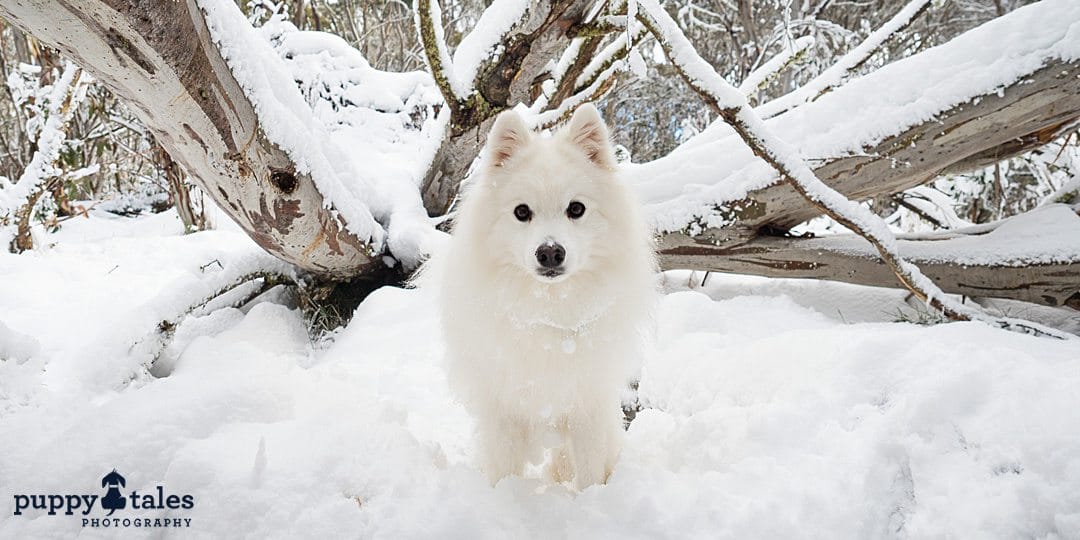
What you should do: Photograph in manual exposure or apply exposure compensation
To make sure that you’re getting that crisp white snow scene, don’t rely on the camera’s automatic settings. Adjust your exposure settings according to the conditions that you have. You can do this by shooting in manual mode or via applying exposure compensation.
If you’re getting underexposed images, increase exposure by about 1 to 1.5 stops to let more light into the photo while still keeping the snow details as well as the real colour of your furry buddy. To make sure you’ve got the right exposure, always check the histogram. Being a light scene you should see more of the pixels to the right – but not being clipped.
Problem #2: Fifty Shades of Blue? Get the white balance right
Your eyes see white when you’re out there in the winter wonderland. However, your camera detects different shades and hues in the snow – like the blues in the shadows or the pinks in a colourful sunset. If you’re using an auto white balance, when you review your photos you’ll probably notice that the whiteisn’t looking quite so white!
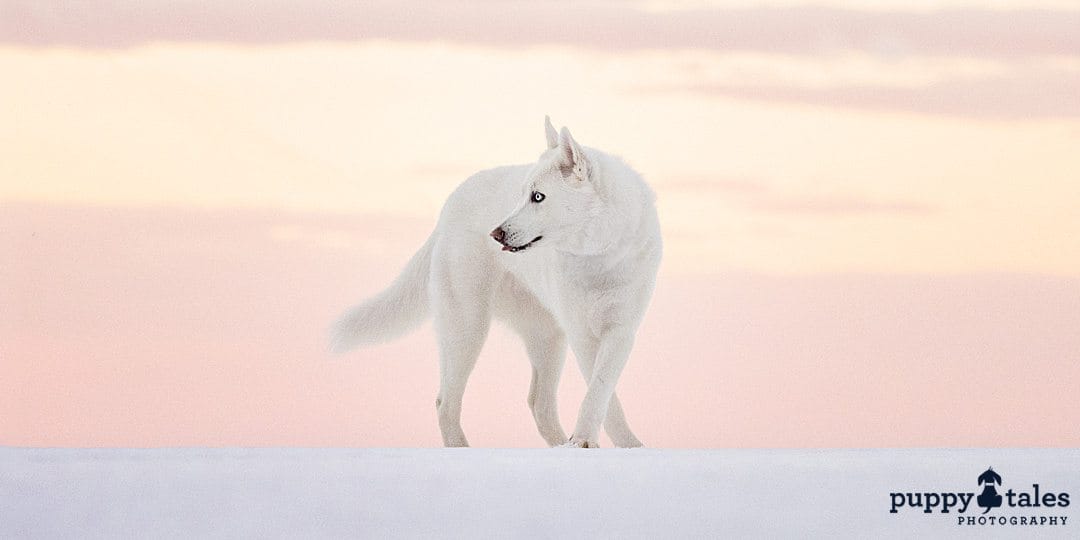
What you should do: Set your white balance
Get the look and feel that you want by setting a custom white balance or selecting one of the camera options that best matches the lighting conditions you have. Balance out the blue of the snow by warming it up with the cloudy or flash setting. Be careful not to go too far – there’s the possibility of introducing colours cast yourself when changing the white balance.
What you should do: Fine-tune in post-production
To further balance out your snow-filled image, if you photograph in RAW you can adjust the white balance and/or reduce the saturation of a colour cast during your post-production.
Problem #3: Losing luminosity? Control the contrasts with a wider dynamic range
Photographing black, dark or spotted pups is already difficult because their glorious black coat absorbs light. No doubt you’ve seen photos where he or she is just a fuzzy black object in the foreground! Taking photos of your dog against the high contrast element of snow makes it even harder. You’re faced with two extremes: a light-absorbing subject on a light-reflecting background.
On sunny bluebird days, you’ll also have dark shadows introduced where the light is blocked by buildings, trees or mountains, while the snow in the direct sunlight is so white so you’ll need sunglasses.
The dynamic range of a camera refers to the measurement between the whitest whites and the blackest blacks in an image, or the lowest and highest values of density and luminance. And when you have a dark subject in a light background (or vice versa) a camera is not going to be able to capture detail through all this light range. Depending on the conditions and the camera you’re using, you may have to make a decision as to which is more important – capturing the whites, or capturing the blacks.

What you should do: Get higher quality camera gear
Generally speaking the more high end your camera gear the wider a dynamic range it will be able to record. For example, a latest-generation iPhone is capable of recording a base dynamic range of approximately 9 stops. The camera I use has a minimum dynamic range of 13.5 stops.
What you should do: Photograph in RAW
Hand in hand with a higher quality camera is the ability to photograph RAW files and achieve a wider dynamic range. This file format allows you to have additional post-production flexibility to darken (burn) the highlights, while raising (dodging) the shadows, giving you the best ability to see the shine of a dog’s coat and the pawprints they’ve left behind in the white snow.
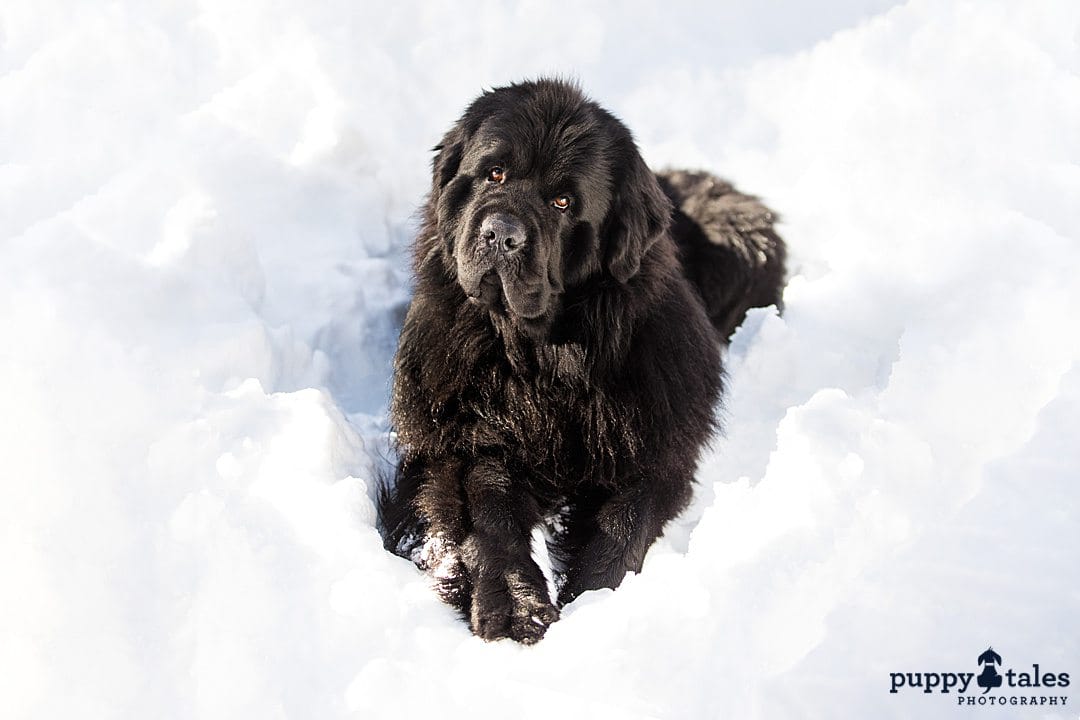
What you should do: Use spot metering
Use spot metering and set it on the dog’s face. The camera will read only the light coming from this specific area and set the exposure based on the light bouncing that area. Achieving correct exposure here is generally going to be the most important factor as you want to be able to see the twinkle of mischief in your pet’s eyes as they wait for that snowball to be thrown!
What you should do: Take note of the lighting conditions
As you move about, consider the lighting conditions around you. Look for full shade, the glow of backlit or use the sun to light the subject. The best option depends on all the variables of where and when you find yourself and your canine subject. But, as you place your dog, look at what the lighting is doing. And, as you take photos, notice which photos look better on your camera.
Generally speaking, it’s easier if you avoid photographing during the brightest part of a sunny day – the snow will only reflect this light and make the photo look even brighter. Speaking of light, don’t shy away from using additional lighting. Use fill flash to reveal the details in your black dog.
Problem #4: Baby, it’s Cold! Layer it up
How can you focus on photographing your dog in the snow if you’re almost frozen? Not to mention that you’re holding a piece of metal in your hands in the middle of winter! And that the best photos of dogs are often taken at eye level or below…. which means lying in the snow!
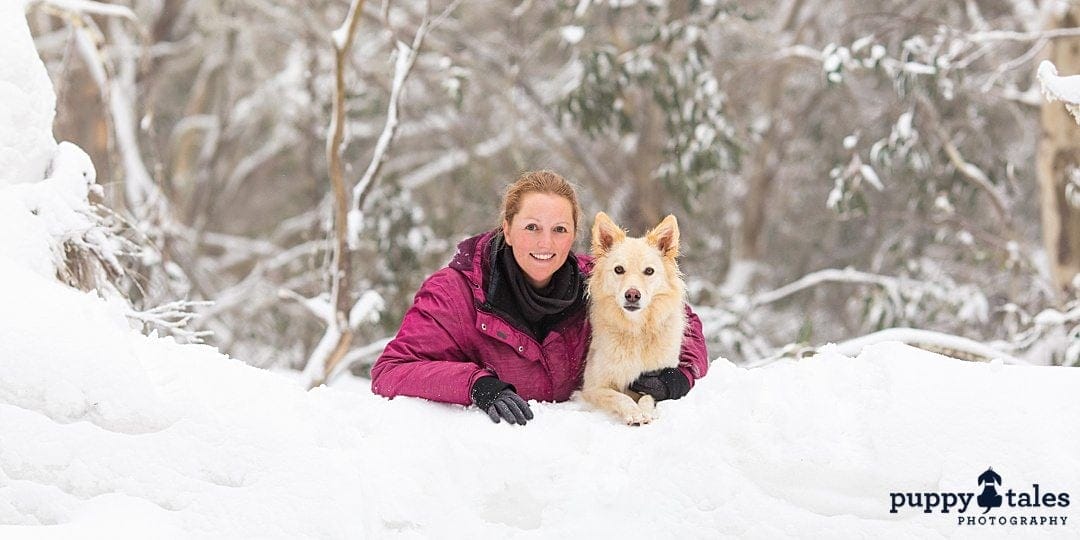
What you should do: Dress for the snow
Stay warm and comfortable by wearing enough layers to keep the cold out. And make sure that the outer layers are waterproof. I recommend Merino wool layers and possum wool for socks, gloves and hats – they are great at keeping you warm. Don’t forget your feet! Put on a trusty pair of warm waterproof boots—there’s nothing worse than numb toes.
Of course, you’ve got to be able to operate your camera with your gloves. Wear fingerless or tactile gloves so your hands are warm, but you’re still able to use the controls and dials on your camera. This ensures that you can stay out for longer and have more opportunities to take photos of your dog.
Problem #5: Cold+Wet = Camera Problems! Protect your gear
Your body isn’t the only thing that is affected by snowy weather. The cold temperature can drain your camera batteries while the changes in temperature can cause your lens to fog and create condensation. You’ll also have to be wary of the snow falling on your lens. If moisture seeps in, your cameras and equipment can be seriously damaged.
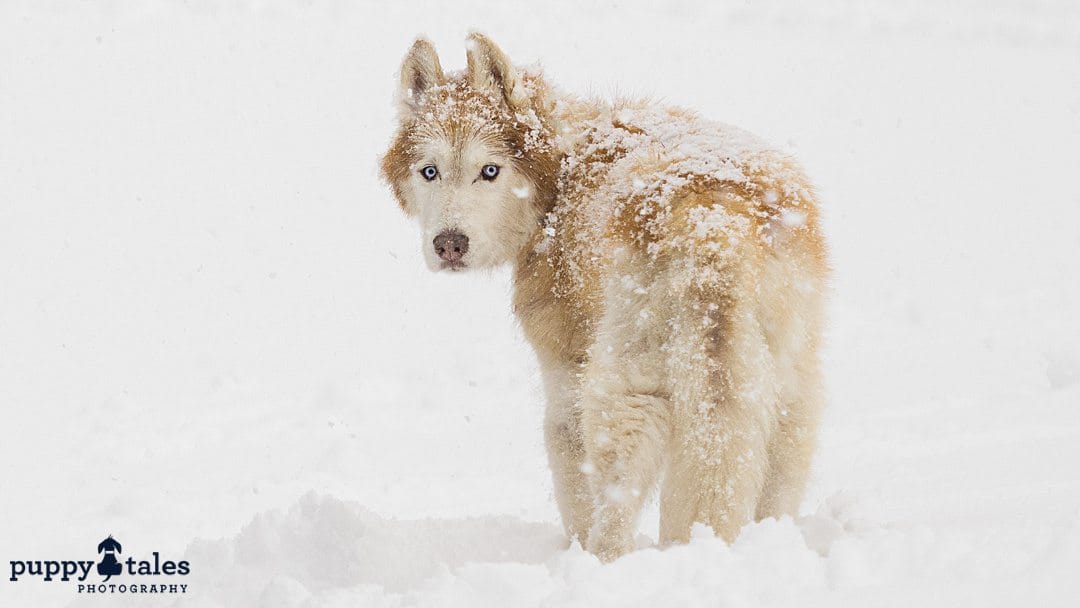
What you should do: Protect your gear
Just like you have to dress for the occasion, your camera gear must also have protection against the cold and moisture. Use a lens hood and a protective filter to keep water (melted snow!) off the lens. Always carry a microfibre cloth in your pocket so you can easily clean your gear if needed.
Higher-end camera equipment will have protective seals to prevent exposure to moisture and water. If your camera doesn’t have this, use a protective case and keep your gear off the snow.
Never change your lens in falling snow because snow/water droplets on your sensor create horrible black dots on your photos and will remain in place until they dry or are cleaned off (which you also don’t want to be doing out in the elements).
It’s common for batteries to die out when it’s cold so make sure you bring spare batteries with you so that you can photograph for as long as you want.
Once you return indoors, put your camera inside a sealed plastic bag so it won’t be affected by condensation. It’s also recommended to place the camera bag in a cooler area of the accommodation (i.e. near the entrance area) so it won’t have to suffer from the drastic change in temperature and it can slowly adjust to the warmth inside.
Problem #6: It’s all too hard, what can I do? Get expert help!
Aside from the difficulties presented by the cold weather and the complex photography techniques you have to learn, photographing dogs is another challenge altogether. They don’t sit still, they move quickly, and they’re easily distracted. It can be a miracle for some dogs to pose, even for just a few seconds. This is why you need someone who’s experienced with photographing dogs.
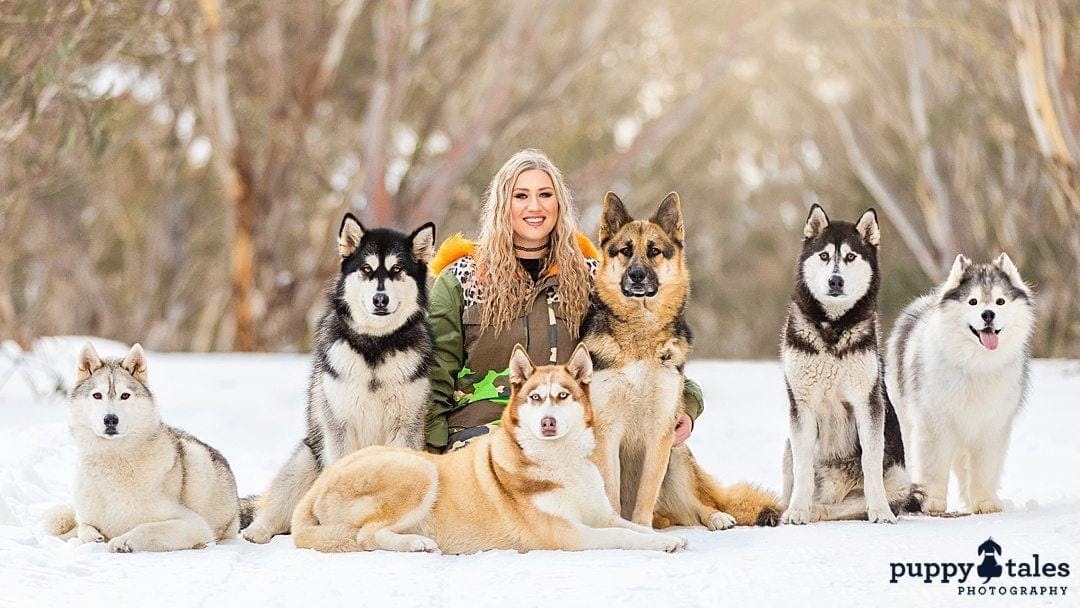
What you should do: Make it easy, make it more fun for yourself and book a Snow Dog photo session
For the last eight years we’ve been heading to Dinner Plain in the High Country of Victoria to photograph dogs in the snow. We know the best spots to photograph during different times of the day, whether it’s sunrise or sunset. Snowfall just started? We know the right place to get that panoramic view of snow-covered landscapes. We also know secret scenic spots that aren’t crowded with people or where we’re less likely to run into other dogs — the pawfect locations around Dinner Plain for your dog’s session. My photos have been awarded many times, including the 2015 Australian Animal/Pet Photographer of the Year wherein two of the four photos in the winning portfolio were of dogs in the snow at Dinner Plain.
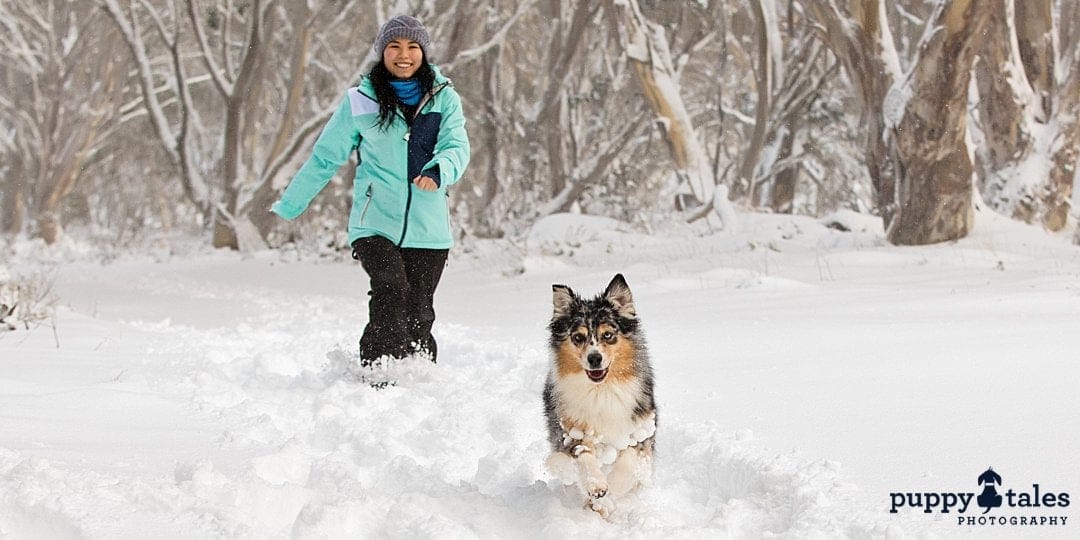
Apart from the skills and experience we have, having someone take photos of your dog lets you be in the moment with your furry buddy. You can even be in photos together! Let us capture you and your dog’s best snow moments.



